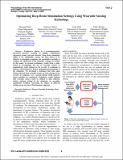| dc.contributor.author | Patel, Shyamal | |
| dc.contributor.author | Mancinelli, Chiara | |
| dc.contributor.author | Hughes, Richard | |
| dc.contributor.author | Dalton, Anthony | |
| dc.contributor.author | Shih, Ludy | |
| dc.contributor.author | Bonato, Paolo | |
| dc.date.accessioned | 2010-10-01T14:58:18Z | |
| dc.date.available | 2010-10-01T14:58:18Z | |
| dc.date.issued | 2009-06 | |
| dc.identifier.isbn | 978-1-4244-2072-8 | |
| dc.identifier.uri | http://hdl.handle.net/1721.1/58816 | |
| dc.description.abstract | Parkinson's disease is a neurodegenerative movement disorder resulting in rigidity, bradykinesia (slowness), tremor and gait disorder. Deep brain stimulation (DBS) of the subthalamic nucleus has been shown to be effective in managing symptoms, but quantitative methods to facilitate the adjustment of the stimulator settings are needed. In this paper, we present preliminary results from a study aimed at investigating the use of wearable sensors to quantitatively track changes in the severity of symptoms in patients with Parkinson's disease undergoing programming of the stimulator. We developed a technique that relies upon features derived from wearable sensors to track changes in the severity of symptoms over a period during which patient's motor activities are monitored. Preliminary results indicate that wearable sensors could be utilized to help clinicians achieve optimal settings of the stimulator by providing quantitative feedback concerning the impact of different settings on the severity of Parkinsonian symptoms. | en_US |
| dc.description.sponsorship | CIMIT: Center for Integration of Medicine and Innovative Technology | en_US |
| dc.language.iso | en_US | |
| dc.publisher | Institute of Electrical and Electronics Engineers | en_US |
| dc.relation.isversionof | http://dx.doi.org/10.1109/NER.2009.5109221 | en_US |
| dc.rights | Article is made available in accordance with the publisher's policy and may be subject to US copyright law. Please refer to the publisher's site for terms of use. | en_US |
| dc.source | IEEE | en_US |
| dc.subject | Deep Brain Stimulation | en_US |
| dc.subject | Parkinson's Disease | en_US |
| dc.subject | Wearable Technology | en_US |
| dc.title | Optimizing deep brain stimulation settings using wearable sensing technology | en_US |
| dc.type | Article | en_US |
| dc.identifier.citation | Patel, S. et al. “Optimizing deep brain stimulation settings using wearable sensing technology.” Neural Engineering, 2009. NER '09. 4th International IEEE/EMBS Conference on. 2009. 6-9. © 2009 IEEE | en_US |
| dc.contributor.department | Harvard University--MIT Division of Health Sciences and Technology | en_US |
| dc.contributor.approver | Bonato, Paolo | |
| dc.contributor.mitauthor | Bonato, Paolo | |
| dc.relation.journal | 4th International IEEE/EMBS Conference on Neural Engineering, 2009. NER '09 | en_US |
| dc.eprint.version | Final published version | en_US |
| dc.type.uri | http://purl.org/eprint/type/JournalArticle | en_US |
| eprint.status | http://purl.org/eprint/status/PeerReviewed | en_US |
| dspace.orderedauthors | Patel, Shyamal; Mancinelli, Chiara; Hughes, Richard; Dalton, Anthony; Shih, Ludy; Bonato, Paolo | en |
| mit.license | PUBLISHER_POLICY | en_US |
| mit.metadata.status | Complete | |
